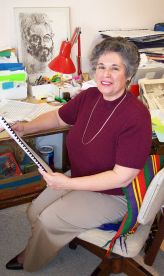
Judith Lang Zaimont is an internationally-recognized composer with an impressive catalogue of close to 100 works, many of which are prize-winning compositions. Her many composition awards include a Guggenheim Fellowship (1983-84); Maryland State Arts Council creative fellowship (1986-87); and commission grants from the National Endowment for the Arts (1982) and Minnesota Composers Forum (1993).
Her orchestral music has been repeatedly recognized through prizes and her works are frequently played in the United States (Carnegie Hall, Lincoln Center) and abroad; they are published (Galaxy/ ECS, Peters, Broude, Sounds Alive!, Vivace, Walton) and recorded (Arabesque, Leonarda, Northeastern). Her music is the subject of nine doctoral dissertations, and several of her works serve as repertoire for performance competitions. Her biography is found in most standard reference works, and she is the subject both of individual chapters in specialist volumes and major articles in professional journals.
She is also creator and editor-in-chief of the critically acclaimed book series, The Musical Woman: An International Perspective (3 vols., Greenwood Press). For this, she received a research grant from the National Endowment for the Humanities (1989), and the 1993 First Prize in the international musicology awards, the Pauline Alderman Prizes.
Formerly a member of the faculties of Queens College and Baltimore's Peabody Conservatory of Music, where she was named "Teacher of the Year" in 1985, Judith Zaimont is a distinguished teacher, and held the post of Professor of Music and Chair of the Music Department at Adelphi University from 1989-91. Since 1992 Zaimont has been Professor of Composition at the University of Minnesota School of Music where she chairs the Theory/Composition Division.
|
|
|
|
|

Monday, February 07, 2005
One Million Notes at Florida State Festival
To initiate this every-so-often report from the front – and after hearing well more than a million new notes over the last three days -- I take up the LISTENER’S question: New Music – Where is ‘The Edge’?
The million-plus new notes reached me as composer participant in the (biennial) international 2005 Festival of New Music hosted by Florida State University. 45 works by composers from both sides of the Atlantic were played over eight Festival concerts, one of which was my wind ensemble movement Growler ( first of three scenes in the 2003 Symphony for Wind Orchestra), ably performed by the FSU Wind Ensemble. While a few were premieres, most works were already into second performances and beyond, and participating composers represented every stage of professional standing from student to veteran.
Instrumental music predominated – chamber works being the most plentiful, with healthy examples of music for orchestra and for wind groupings. None of the pieces included improvisation as a significant feature. Even so, the Festival provided for a bracing and informative snapshot sampling the ‘inquisitive new’.
Performances were generally quite good. And the overall craft/skill quotient displayed in the writing was definitely high. So it was possible to discern with great clarity the clean stylistic delineators that identified international works as distinct from American compositions ( and within the latter grouping, some salient examples of ‘regional accents’).
My observations really began well into the third concert when I found myself quite relishing the few pieces that presented something really NEW. I found myself on a quest for pieces that at least tried to dare in some way – and preferably in more than one way at once. Ultimately, it was bracing to encounter quite a high percentage of pieces that took the effort, care and attention to be special.
The lingering disappointment, though, has to do with safe choices made by a fair number of the American composers. I was actually surprised by the tameness of the musical materials selected by certain of these, and soon identified definite processes at work that promote making listening more of a ho-hum encounter than one of intense involvement. Models for some of these self-limiting processes include:
- Nicely imagined shapes, but the musical materials remain totally static within a particular scale formation.
- A dogged thoroughness to explore all extrapolations of configuration within one static harmony. (*There’s a reason change-ringing is not commonly considered an ‘artistic’ performance!)
posted by Judith Lang Zaimont
12:05 AM
|
| |



